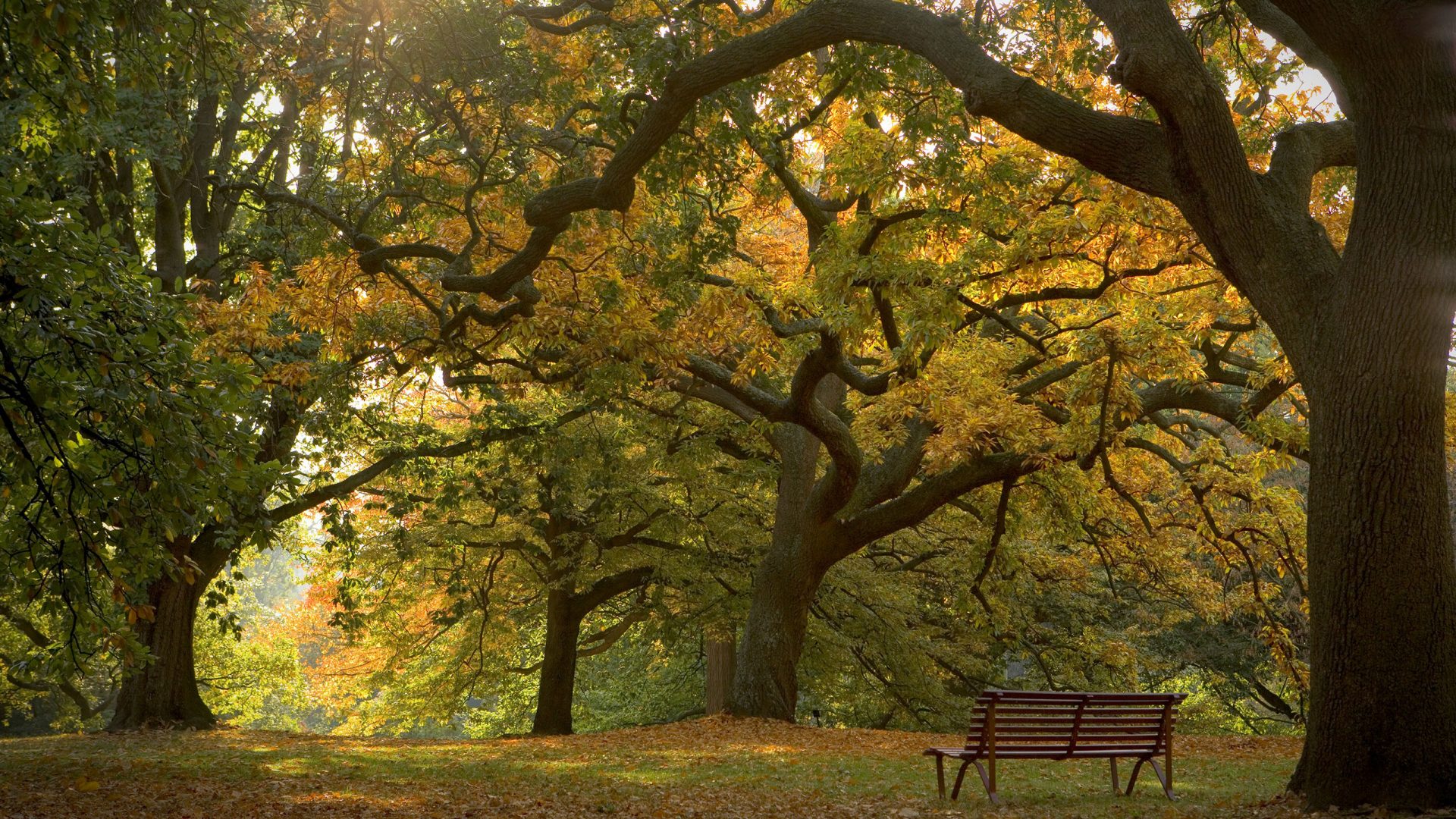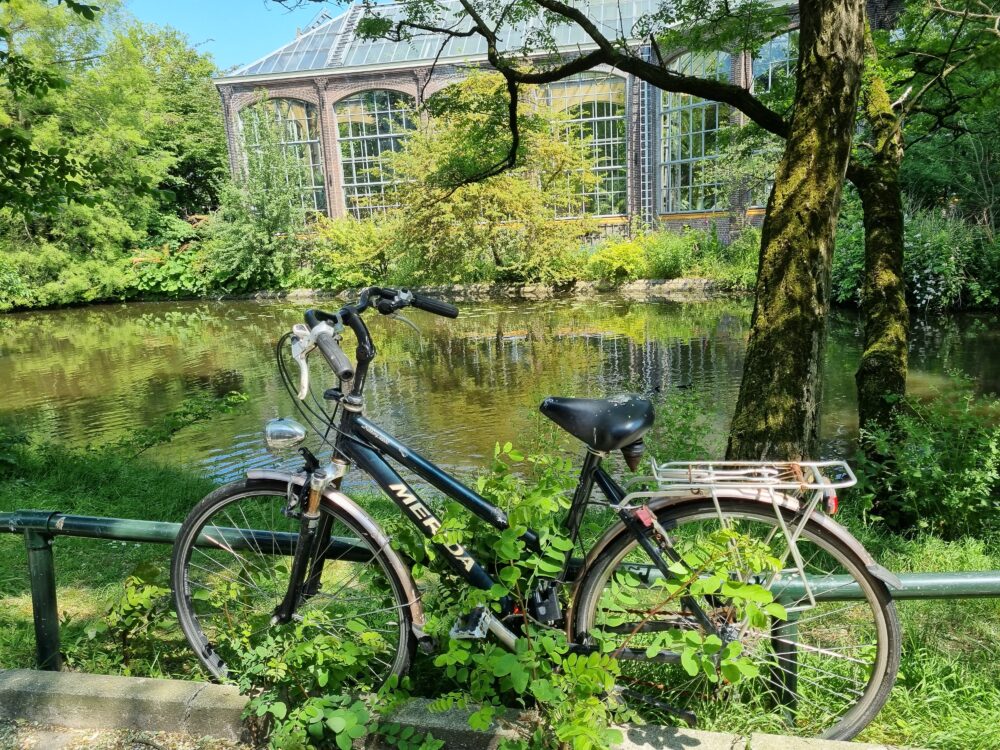Claudia Hyles (AGHS ACT, Monaro and Riverina) visited Amsterdam earlier in 2023 and reports on its green spaces.
Late spring and early summer in Amsterdam is a time for enjoying beautiful gardens, not only the famous bulb-fields at nearby Keukenhof. In the old residential areas of the city located for more than 400 years along the ring of canals, there are several house museums, some with delightful gardens. One, the Museum Van Loon, has a charming formal 17th century garden and carriage house behind the edifice.
There are 30 parks in Amsterdam ranging in size from one hectare to almost 50. The big ones are full of people – joggers, families playing games, others having picnics or simply rambling. Some parks are less manicured and of a wilder nature than those in other European cities; they too seem very people-friendly.
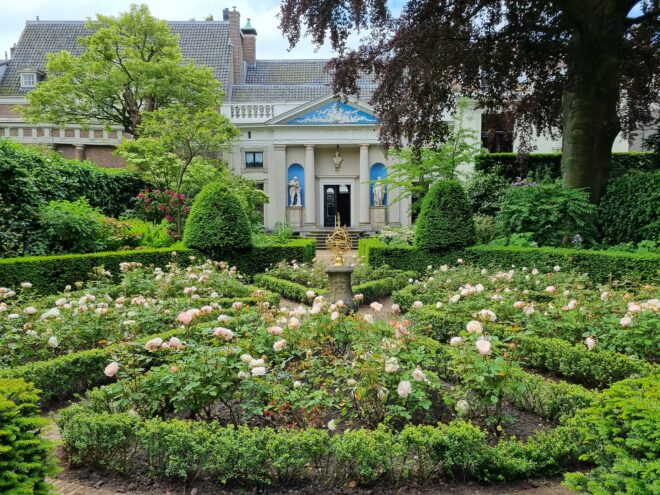
All these express the reality of Amsterdam’s green vision (2020-2050). The city’s Green Vision 2020-2050 includes these measures:
- Green routes: a 10-minute walk from your front door to a park, a 15-minute bike ride to a nature reserve.
- A ‘green by default’ principle: wherever possible, we [the city] replace paving stones, bricks and asphalt with greenery to create a natural living environment with space for social interaction.
- Public and accessible green spaces: allotments, sports parks and school gardens will become more accessible and inviting to a wider public.
- Landscape parks: directly surrounding the city, we are creating areas for wilderness, spaces for urban agriculture and more facilities for sport and exercise.
- New forest and parks: a new urban forest and new urban parks will be created.
Vondelpark, at 47 hectares, is the largest in the city and attracts 10,000,000 visitors per year. It is a great place for a power walk with promise of a seat in a café afterwards. Less crowded, at least on weekday mornings, are two charming parks in the south. Frankendael Park is Amsterdam’s only remaining 17th century country estate. There are formal gardens, flowery meadows and wild vistas, an orchard, floating iris-bedecked rafts of vegetation rocking gently on narrow waterways, nesting storks on top of a free-standing chimney and in one section, small dwellings set in pretty cottage gardens. Would-be custodians wait for years for a rental vacancy.
Sarphati Park is smaller but greatly used by the inhabitants of surrounding neighbourhoods. There is an enticing playground for children, a watercourse, and a 19th century statue of Samuel Sarphati (1813–1866). He was a physician who, after encountering bad hygiene among Amsterdam’s poor, promoted many projects designed to improve the quality of life and health of the city and its population. This included a bread factory, collection of refuse and other sanitation services. A wonderful man, he also initiated improvements in education and industrialisation. Dr Sarphati was Jewish and during the Nazi occupation the park was renamed. After the war, happily his name was restored.
Greening de Pijp
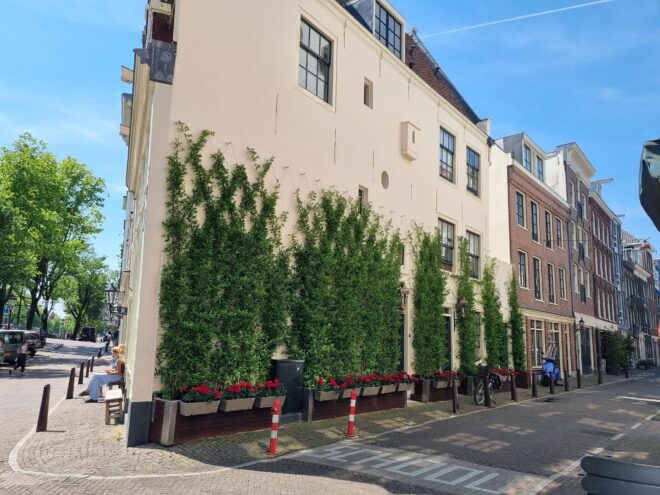 The older section of de Pijp, where Sarphati Park is located, was built cheaply in the last quarter of the 19th century to accommodate a rapidly expanding population. In the spirit of Dr. Sarphati, the original plans were idealistic but few of the original ideas were retained when the suburb came to be constructed, as quickly as possible. It became an area of long streets with a typical street wall profile, usually four or five storeys tall. In the late 20th and early 21st centuries, a great greening has taken place and one interesting feature is the proliferation of pavement gardens. In the recent past, primarily driven by climate, environmental, and sustainability issues, deliberate efforts have been made to transform the image of a rather seedy, run-down area with a reputation for drugs and graffiti. Larger streetscaping projects such as an alternating car park/garden bed program have been launched and mature trees introduced in the hope that a more beautiful streetscape will encourage better public behaviour.
The older section of de Pijp, where Sarphati Park is located, was built cheaply in the last quarter of the 19th century to accommodate a rapidly expanding population. In the spirit of Dr. Sarphati, the original plans were idealistic but few of the original ideas were retained when the suburb came to be constructed, as quickly as possible. It became an area of long streets with a typical street wall profile, usually four or five storeys tall. In the late 20th and early 21st centuries, a great greening has taken place and one interesting feature is the proliferation of pavement gardens. In the recent past, primarily driven by climate, environmental, and sustainability issues, deliberate efforts have been made to transform the image of a rather seedy, run-down area with a reputation for drugs and graffiti. Larger streetscaping projects such as an alternating car park/garden bed program have been launched and mature trees introduced in the hope that a more beautiful streetscape will encourage better public behaviour.
In Sarphati Park, a rustic cottage, once the pumping station for the park’s waterway, is now the home for the Groen Gemaal project. Translated as Green Pumping Station, it is run by neighbourhood volunteers and staff from the local De Pijp Community Centre. There is a seed and plant exchange and an opportunity to borrow tools. Seniors and people with a disability can request help to control unruly plants in their pavement gardens and advice is given on pruning, watering, composting, choice of plants for sun or partial shade and importantly, how to be part of the Bee Ribbon. By choosing pollen and nectar-rich plants, bees – so crucial in the role they play in vegetable and fruit production – can be encouraged in the little strip gardens abutting tall residential buildings.
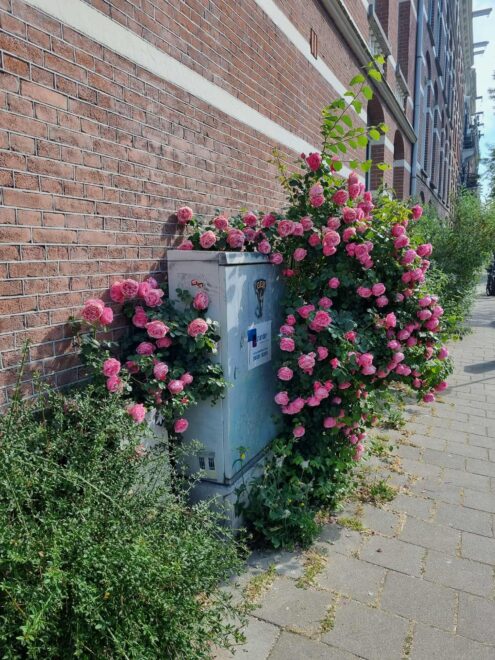
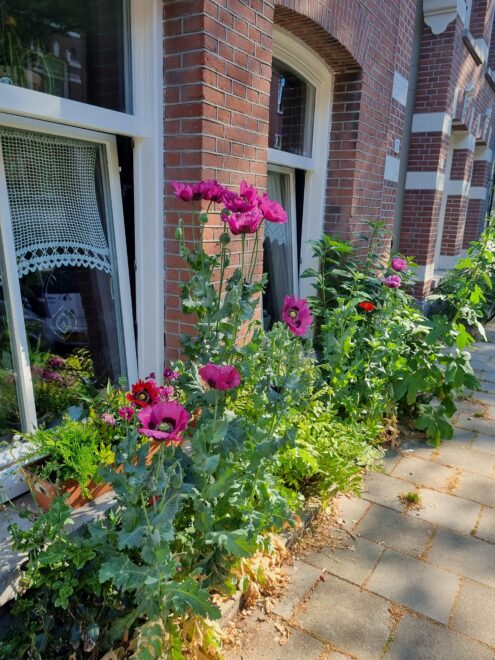 Application for a pavement or faςade garden is made to the Amsterdam Local Authority. Once approved, the authority installs the garden free of charge. They pull up the pavers, remove sand, replace it with soil in a plot measuring the length of the building, not including the front door. Residents of upper floors seeking to establish a garden, must first ask permission from ground floor residents. The maximum depth of the plot is 45 cm from the building’s façade (on wider footpaths a maximum of 60 cm is permitted). After construction 1.80 meters of footpath must remain.
Application for a pavement or faςade garden is made to the Amsterdam Local Authority. Once approved, the authority installs the garden free of charge. They pull up the pavers, remove sand, replace it with soil in a plot measuring the length of the building, not including the front door. Residents of upper floors seeking to establish a garden, must first ask permission from ground floor residents. The maximum depth of the plot is 45 cm from the building’s façade (on wider footpaths a maximum of 60 cm is permitted). After construction 1.80 meters of footpath must remain.
Then the future is up to the keen gardener. Not all pavement gardens are the excavation type. There are window-boxes, hanging baskets, pots on steps, ledges, windowsills, and odd little niches. Elsewhere advanced shrubs and trees thrive in impossibly small holes cut into the concrete. In older parts of the city such as Jordaan, and in other Dutch towns and cities, established pavement gardens are also a glorious sight.
On warm summer nights, residents may be seen eating dinner, sipping wine, or just watching the world go by, seated on battered old chairs or attractive garden benches, often securely chained to something immoveable, shaded by climbing roses, wisteria or jasmine. Some vines climb all the way up to fourth and fifth floor apartments. Last summer was an excellent season for roses, foxgloves, hollyhocks and opium poppies. There was riot of colour and scent wafted through the air. It is yet another reason for visiting the fascinating city of Amsterdam.
All images, Claudia Hyles

